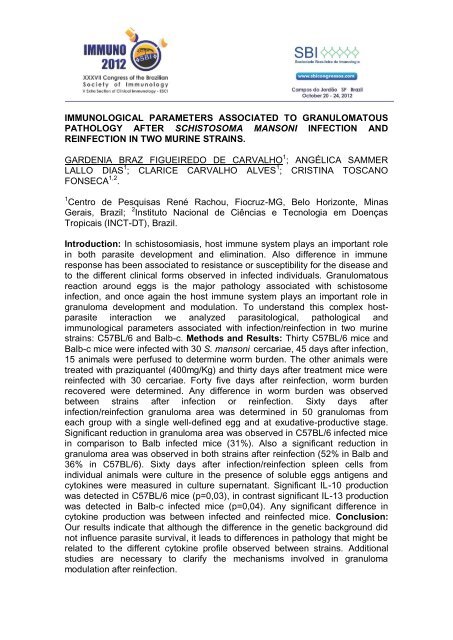immunology of infectious and parasitic diseases - XXXVII Congress ...
immunology of infectious and parasitic diseases - XXXVII Congress ...
immunology of infectious and parasitic diseases - XXXVII Congress ...
You also want an ePaper? Increase the reach of your titles
YUMPU automatically turns print PDFs into web optimized ePapers that Google loves.
IMMUNOLOGICAL PARAMETERS ASSOCIATED TO GRANULOMATOUS<br />
PATHOLOGY AFTER SCHISTOSOMA MANSONI INFECTION AND<br />
REINFECTION IN TWO MURINE STRAINS.<br />
GARDENIA BRAZ FIGUEIREDO DE CARVALHO 1 ; ANGÉLICA SAMMER<br />
LALLO DIAS 1 ; CLARICE CARVALHO ALVES 1 ; CRISTINA TOSCANO<br />
FONSECA 1,2 .<br />
1 Centro de Pesquisas René Rachou, Fiocruz-MG, Belo Horizonte, Minas<br />
Gerais, Brazil; 2 Instituto Nacional de Ciências e Tecnologia em Doenças<br />
Tropicais (INCT-DT), Brazil.<br />
Introduction: In schistosomiasis, host immune system plays an important role<br />
in both parasite development <strong>and</strong> elimination. Also difference in immune<br />
response has been associated to resistance or susceptibility for the disease <strong>and</strong><br />
to the different clinical forms observed in infected individuals. Granulomatous<br />
reaction around eggs is the major pathology associated with schistosome<br />
infection, <strong>and</strong> once again the host immune system plays an important role in<br />
granuloma development <strong>and</strong> modulation. To underst<strong>and</strong> this complex hostparasite<br />
interaction we analyzed parasitological, pathological <strong>and</strong><br />
immunological parameters associated with infection/reinfection in two murine<br />
strains: C57BL/6 <strong>and</strong> Balb-c. Methods <strong>and</strong> Results: Thirty C57BL/6 mice <strong>and</strong><br />
Balb-c mice were infected with 30 S. mansoni cercariae, 45 days after infection,<br />
15 animals were perfused to determine worm burden. The other animals were<br />
treated with praziquantel (400mg/Kg) <strong>and</strong> thirty days after treatment mice were<br />
reinfected with 30 cercariae. Forty five days after reinfection, worm burden<br />
recovered were determined. Any difference in worm burden was observed<br />
between strains after infection or reinfection. Sixty days after<br />
infection/reinfection granuloma area was determined in 50 granulomas from<br />
each group with a single well-defined egg <strong>and</strong> at exudative-productive stage.<br />
Significant reduction in granuloma area was observed in C57BL/6 infected mice<br />
in comparison to Balb infected mice (31%). Also a significant reduction in<br />
granuloma area was observed in both strains after reinfection (52% in Balb <strong>and</strong><br />
36% in C57BL/6). Sixty days after infection/reinfection spleen cells from<br />
individual animals were culture in the presence <strong>of</strong> soluble eggs antigens <strong>and</strong><br />
cytokines were measured in culture supernatant. Significant IL-10 production<br />
was detected in C57BL/6 mice (p=0,03), in contrast significant IL-13 production<br />
was detected in Balb-c infected mice (p=0,04). Any significant difference in<br />
cytokine production was between infected <strong>and</strong> reinfected mice. Conclusion:<br />
Our results indicate that although the difference in the genetic background did<br />
not influence parasite survival, it leads to differences in pathology that might be<br />
related to the different cytokine pr<strong>of</strong>ile observed between strains. Additional<br />
studies are necessary to clarify the mechanisms involved in granuloma<br />
modulation after reinfection.



